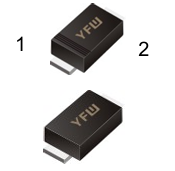Date:2025-05-30 Categories:Product knowledge Hits:326 From:Guangdong Youfeng Microelectronics Co., Ltd
Grounding Design: The grounding end of the TVS should be connected to the circuit ground with a short and thick wire to ensure good grounding. A good grounding can quickly discharge the transient current, improving the protection effect. The grounding wire's cross-sectional area should be appropriate to avoid excessive resistance.
Heat Dissipation Consideration: For TVS diodes with higher power ratings, consider heat dissipation measures. Install the TVS on a heat sink or in a well-ventilated area to prevent the TVS from overheating and failing due to prolonged operation under high power conditions.
Series Resistance Application: In some cases, a small series resistance can be connected in series with the TVS to limit the current flowing through the TVS during a transient event. This can protect the TVS from excessive current damage and also reduce the impact of the TVS on the normal operation of the circuit. The value of the series resistance should be selected according to the specific circuit conditions.
Combination with Other Protective Devices: TVS diodes can be used in combination with other protective devices such as fuses and inductors to form a more comprehensive protection system. For example, a fuse can be connected in series with the TVS to cut off the circuit in case of a severe overcurrent situation, protecting the TVS and the entire circuit.
PCB Layout: On the printed circuit board (PCB), place the TVS diodes as close as possible to the protected component to minimize the loop area between the TVS and the protected component. This can reduce the influence of electromagnetic induction and improve the protection efficiency. Arrange the components reasonably to ensure the clarity and rationality of the PCB layout.

Previous: Classification, Structure, and Principle of MOSFET
Next: Application Cases